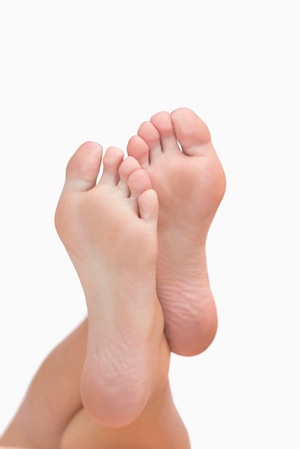
Although they're located at the farthest distance from your brain, the health of your feet can give you clues about the health of your brain, mainly whether your brain is receiving enough oxygen. When circulation to the feet is poor, creating a variety of symptoms discussed below, this is a red flag circulation to the brain is compromised as well. Just because you can breathe doesn't mean your brain is getting enough oxygen.
If your brain is not getting enough oxygen it won't function well. You may notice brain fog, declining memory, that you tire more easily, and that it is harder to learn new things. Depression is another common symptom. Poor brain oxygen is a serious matter because it accelerates degeneration of your brain—vascular dementia from lack of blood flow to the brain is the second most common type of dementia after Alzheimer's.
Feet symptoms that could point to problems in your brain
Cold toes and feet. If your feet and toes are colder than your ankles or calves, this means circulation is poor to your feet, and hence to your brain. It's hard to measure your own skin temperature so have someone else compare the temperature of your calves and ankles with that of your feet and toes. If the feet and toes are colder than your ankles and calves this means your circulation to the furthermost regions of your body is compromised. Cold fingers and a cold nose are common too.
Chronic fungal growth in toenails
Do you have chronic fungal nail infections, or chronic athlete's foot? When circulation is poor the blood is not able to carry oxygen, immune cells, and nutrients to the feet to keep them healthy. As a result, infections can take root and be difficult to impossible to banish while circulation is poor. General nail health will also be poor. This is a sign circulation in your brain is also compromised.
White nail beds; poor capillary refill time
The nail beds of your toes should be a healthy pink color. If they are pale or white this is another symptom of poor circulation. Also, when you press down on a nail bed it turns white, but the pink color should return instantly. If it takes a few seconds for the color to return, this means blood flow to the nails is poor, as is blood flow to the brain.
Foot cramps
Sometimes people with poor circulation get foot cramps that seem impossible to relieve. This is because there is not enough blood and oxygen flowing to the muscles in the feet. They may also get cramps in their hands. Again, these are signs blood flow to the brain may be poor.
How to restore blood flow to your feet and your brain
It's important to rule out a health condition that can cause poor blood flow to your feet, such as hypothyroidism, anemia, a heart condition, diabetes, or low blood pressure. Normal blood pressure is considered 120/80. If either number is 10 or more points below that it means blood is not getting pushed into these more distant capillaries of the feet and brain. People with low blood pressure typically also have low blood sugar (reactive hypoglycemia) and adrenal fatigue, a condition in which their stress response system is worn out.
It's important to stabilize blood sugar by avoiding sugars and processed carbohydrates and not skipping meals. Exercise is great for increasing circulation, especially short bursts of high-intensity exercise. Also, a variety of nutritional compounds can support blood flow to your feet and your brain. Ask my office for advice and check out the book Why Isn't My Brain Working?



Latest from the Blog
The Death of Red Dye #3
January 15, 2025What Is Red Dye No. 3? Red Dye No. 3, or Erythrosine, is a synthetic food color derived from coal tar. It was first approved by the FDA in the 1950s and quickly became one of the most popular artificial colors in food and cosmetics. Red Dye No. 3 was used in everything from candies, […] Read more
Latest from the Blog
Do You Know What Is In Your Protein Powder?
What’s Really in Your Protein Powder? Understanding the Risks Protein powders are a staple in many health-conscious diets, from athletes seeking muscle recovery to those simply aiming to boost their daily protein intake. With a wide variety of options available, choosing the right one can feel overwhelming. However, recent findings have raised concerns about what’s […] Read more